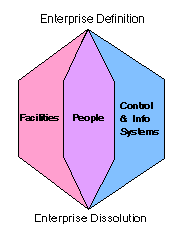
In fact however, each of the three components has an interface with the other two, so the PERA diagram might actually be better represented as "wrapped around" a sphere. Unfortunately, this is difficult to represent on a two dimensional page.

The PERA Enterprise Lifecycle Model is comprised of three basic components:
These are depicted as three "columns" which begin with Enterprise Definition and end with Enterprise Dissolution (see diagram below).
 |
In fact however, each of the three components has an interface with the other two, so the PERA diagram might actually be better represented as "wrapped around" a sphere. Unfortunately, this is difficult to represent on a two dimensional page. |
 |
The next most basic way to structure the enterprise model is by "phase" as indicated by this diagram. During each phase of the enterprise, different diagrams and documents are used to reflect the developing detail as the enterprise moves from initial Definition to Operations Phase, to Dissolution.

Taken together, the above defines the Enterprise Lifecycle Model
Although formats for documenting of each of the three model components (Facilities, People and Systems) will vary, the intent is to support a coherent and coordinated representation of the enterprise during each phase. For all three components, additional detail is added in each sucessive phase by building on the information defined in the previous phase.
Since PERA represents the full life cycle of the Enterprise, all existing Enterprise documents and tools are meant to fit within its structure. As the Enterprise is developed, and increasing levels of detail are defined, it is possible to see how each of the contributing groups and their "deliverables" are related to the others.
Since PERA is a GERAM (General Enterprise Reference Architecture and Methodology), it may be used to represent any enterprise in any industry or business sector.
For more discussion of the concept of Enterprise Architectures, see "What is an Enterprise Architecture" in the Frequently Asked Questions section.